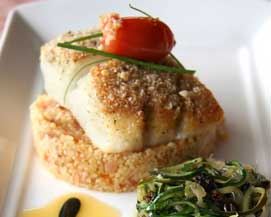Couscous
 |
Couscous, a pinhead-sized pasta, is a traditional North African ingredient. It is easy to prepare and especially delicious after absorbing flavorings during the steaming process. |
Couscous is made by adding water to coarsely ground durum wheat grains and coating them with flour. The dried, hardened pasta pellets are then boiled, steamed, or steeped to become fluffy with a light texture. Bland by itself, couscous easily absorbs the flavors of other foods. The dish “couscous” is a traditional Middle Eastern entree that may be made from other grains as well.
In North Africa and , couscous is deemed part of culinary heritage, from kseksou betfaya (caramelized onion couscous) to couscous a la Marocaine (Moroccan). The pasta is served at social events and religious celebrations, usually with a vegetable stew (tagine) or meats such as lamb and rabbit.
Varieties
Sometimes called “patina,” the grains are sold as fine, medium, and coarse grades.
“Instant” couscous requires very little preparation time as it is partially cooked before drying. Traditional couscous takes much longer for presoaking and is preferred by many cooks. Flavored products are available for convenience.
Buying Tips
While instant couscous is readily available, ethic markets will carry the traditional version for steaming with broths and stews.
Storage Tips
Grains will keep well for at least one year.
Usage Tips
• Couscous pellets will nearly triple in size during cooking or steeping.
• A bay leaf will help repel pantry pests that invade pastas and grains.
• Add sweeteners (raisins, sugar, cinnamon) for a dessert treat.
• Steam uncovered for a drier grain; covered for thicker and moister results.
• Chill the steamed grains and include in a salad.
• Toss steamed couscous with olive oil and lime juice.
• The easy way to prepare couscous is with a couscousier, which is similar to a double boiler. Vegetables, meats, spices, and herbs simmer below while the couscous steams in the perforated upper pot and absorbs the flavors.





